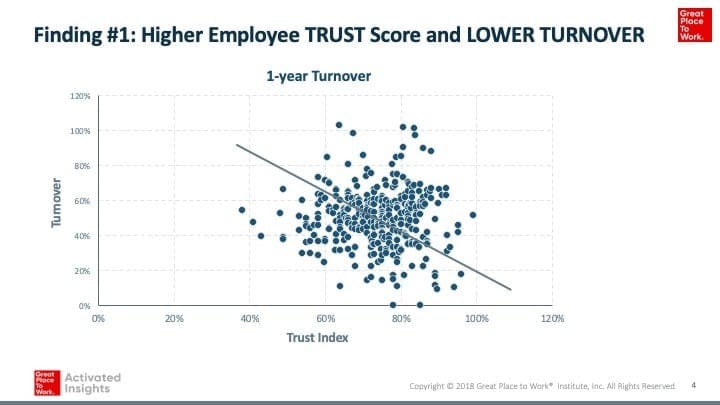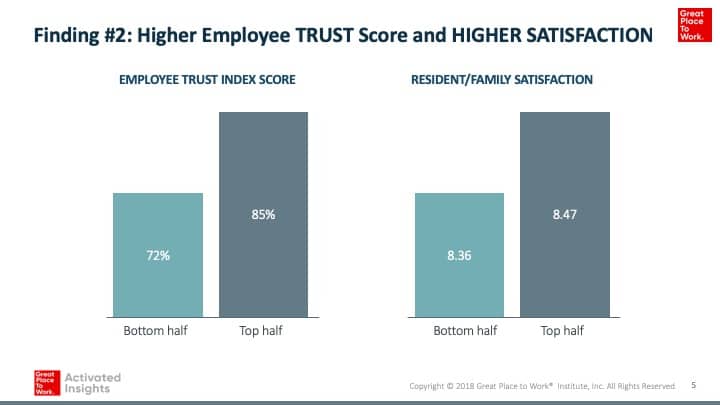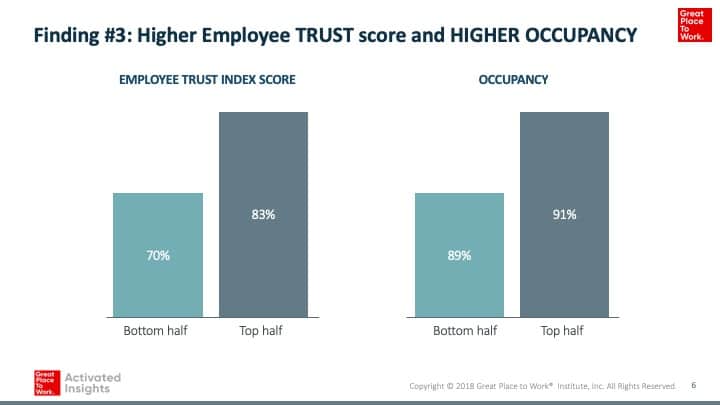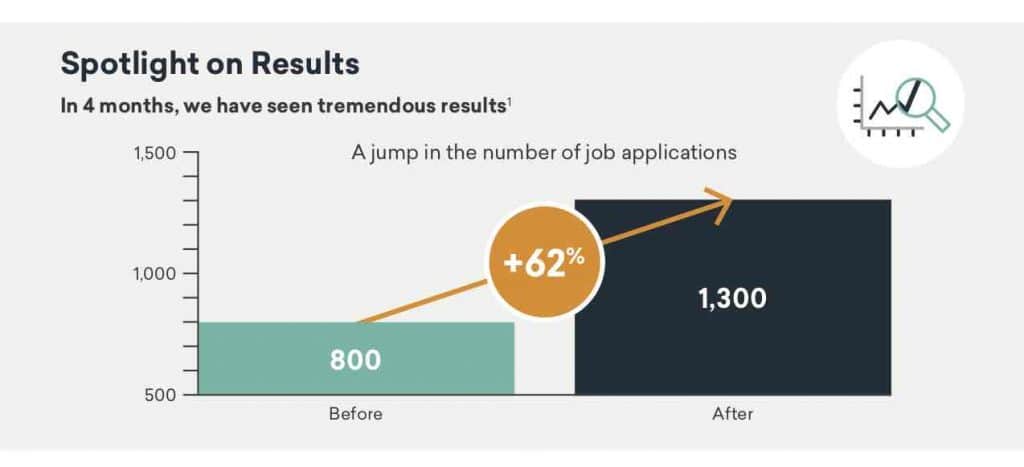Guest blog by Jacquelyn Kung, Ph.D., CEO of Activated Insights
After all, we are a people-to-people sector: good care comes from a great workforce.
Moreover, as you may have seen in the popular TED talk by Wharton and London Business School Professor Alex Edmans, an engaged workforce also leads to great organizational performance. Five years of research has shown it’s causal and not merely a correlation. And given the 15+ million data points amassed in our sector so far, we share our predictions for the senior living workforce for this year and beyond:
Prediction #1: Investors and Boards will demand the Trust Index as a canary-in-the-coal-mine metric for overall organizational performance
At Activated Insights, the senior care arm of Great Place to Work Institute, we are seeing an unprecedented level of interest by investors in workforce data. This is happening on both the equity and the debt side – because of the impact of the workforce on underwriting factors such as occupancy and EBITDA. In particular, REITs are interested in assessing new properties with Trust Index employee score data.
Why is this? Because the data shows that in our sector, better employee TRUST scores indicate better performance across key indicators.
Specifically, better TRUST scores are tied to:
-
Finding #1: lower first-year employee turnover

-
Finding #2: higher customer satisfaction (with even greater effects than in the visual in Admin and Dining/F&B)

-
Finding #3: higher occupancy (with greater effects when market dynamics such as median home prices, available inventory, and new construction by for-profits are controlled for)

In the nonprofit sector, equity investors are less relevant. What we are starting to see here is: Board of Directors such as United Methodist Communities have made being an Employer of Choice (signaled by being certified as a Great Place to Work) a lynchpin to their strategy – and prominent even on the cover of their annual report (seen here).
Prediction #2: The Employer of Choice strategy means speaking in a way job candidates understand immediately – which then translates into increased applicants and quality of talent
As HR leaders who have come from other industries and companies such as Nike, Staples, and Hasbro have shared, “Employer of Choice” means different things to different industries. In the senior living sector, we have been the “ugly stepchild” of healthcare – in other words, not a career choice for much of the eligible working population.
But what has helped is promoting the many ways of being a great employer – and in particular, the badge of honor of being certified as a Great Place to Work. One 40+ building SNF provider wrapped buses and job ads with the fact that they are certified as a workplace, and their head of talent noted an unusual rise in the talent quality applying to key roles. She said, “Candidates tell me it’s because they saw our Great Place to Work certification and that led them to learn more about our organization…and that’s how they ended up applying.”
One nonprofit provider (SpiriTrust Lutheran) took it a step further: they redid their recruiting website and promoted their certification (including on a billboard and increasing their social media presence)…and within months saw the number of job applications skyrocket from 800 to more than 1,300:

Prediction #3: Innovation growth drivers are shifting between for-profits and nonprofits, between hospitality/healthcare and senior living
Given Ziegler’s recent (October 30, 2018) report which showed as the first finding that nonprofits are losing to the for-profits in growth, we are also seeing a noticeable difference in growth rates. Given innovations across technology, workforce, and other key areas have historically been happening in nonprofits, we are noticing a shift of innovation (perhaps due to the shifting of scale and growth) from nonprofits to for-profits.
For instance, one of the largest grantors of scholarships and employee aid (in absolute dollars and in percent of population) is a large Midwest provider called Trilogy. Their innovation is actually allowing employees to contribute $1 from their paycheck to help others, which the majority of their employees elect to do (and in a twist of behavioral economics, this innovation allows employees to receive help at higher rates, too. See the innovation there? It’s subtle and brilliant.)
Furthermore, we are seeing a shift of innovation from hospitality and healthcare into our senior living sector. Once the Fortune Best Workplaces in Aging Services list was announced, the CHRO of a major global luxury brand called and said, “I’ve been losing some of my best and most innovative managers to this sector…can I learn more?” This is just one indication of the shift that is to come.
We have much more work to do – but it’s already exciting to see the shift of power from other sectors to ours. And within ours, it’s exciting to see the focus on culture because it’s the right thing to do and because it’s better for organizational performance; through happier customers and other indicators.
—
To stay up-to-date on all the trends within the senior living field, click here to sign up for Love & Company’s Leaders’ Board newsletter. For a deeper dive into how these trends can impact your organization, call Tim Bracken at 410-207-0013.





